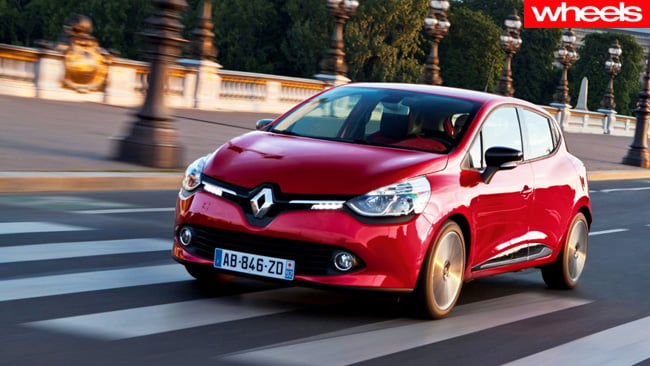After a six-year hiatus, the full Renault Clio range is returning to Australia, and what a brilliant comeback it promises to be. So great is this all-new, fourth-generation model that it may dethrone the Polo in the light-hatch class when it lobs here next October for around $17K. Sacre bleu! France is back in the segment it once dominated.
The Clio is bread-and-butter for its marque in Europe, so this new model needs to fire. It is the first Renault to be designed by Laurens van den Acker, who was poached from Mazda to define a new design language for the brand. Driving behind a new Clio, it appears taut and squat, the bulged rear haunches and Alfa-esque hidden rear doorhandles particularly appealing. The thorough modernisation (fashionisation?) of Clio extends to the cabin, a meld of rather nice bathmat-rubber-style, soft-touch plastics, piano-black trim, seven-inch touchscreen, and customisable dash colours (see breakout). A downside is that Renault has prioritised luggage space over rear legroom, with a generous 300-litre cavity offset by limited knee and foot space; there’s more rear space in its smaller Peugeot 208 rival.
Despite larger dimensions than Clio III (35mm longer/24mm wider), a classier cabin, and stronger body, the base Clio IV weighs around 100kg less, at just 1009kg. Lift the bonnet and part of the reason is obvious. The 0.9-litre three-cylinder petrol-turbo engine, badged TCe90 to reflect its 90hp (66kW) output, sits in an engine bay clearly designed to accept larger tackle. The 1.5-litre turbo-diesel option, named dCi90 for the same reason, fills the empty space left behind and beside the three-potter, and adds 61kg kerb weight.
Both engines complement, rather than compete, with each other. In the context of its breed, the three-cylinder petrol is the most outstanding. The barest of sewing-machine vibes stream to the wheel at idle, but not annoyingly so. Otherwise, the engine is near-silent when you want it to be – when idling or cruising – and even when it gets its growl on when pressed, it remains impressively unobtrusive.
Thanks to a low-inertia turbo (Renault claims the lowest on the market), 90 percent of its peak 135Nm is available from 1650rpm, and the full figure comes on strong from 2500-3500rpm. The turbo-triple offers comparable torque to the atmo 1.4-litre Polo (132Nm) and 1.5-litre Mazda 2 (137Nm) but those rivals don’t produce their peaks until circa-4000 revs.
Its 66kW at 5600rpm ensures the base Clio isn’t fast, although its 13.2-sec 0-100km/h claim feels closer to the diesel’s 11.4sec time. The turbo-triple’s driveability and refinement are what impress most. It feels torquey at the lower end of the tach, exactly where a larger-capacity atmo four struggles.
Ultimately, though, there isn’t quite enough there to capitalise on the chassis. The platform is a Clio III carry-over, with a longer wheelbase (by 14mm) and wider tracks (up 34mm front/36mm rear). Sounds (is) geeky, but I was genuinely excited to see all test cars riding on sensible 195/55 R16 Continental EcoContact rubber. It would be romantic to say the Clio reintroduces old-school French ride quality, all lushness and waftiness, but it’s better than that. There’s an inherent layer of firmness around town that promises – and delivers – excellent body control, but when tackling really rough imperfections, its compliance and isolation are also premium-grade.
The electro-mechanical power steering intially feels a tad vague, too light and artificial in the first movements, but the system subtly backs off the assistance at speed. The result is precise lane-change movements on the freeway and genuine feel and feedback when connecting apexes.
Oh, the handling. A defining photo of the old, old base Clio II is in Wheels, February 2002, showing a metallic sky-blue example cornering with its inside rear hoisted in the air. It’s like that with the new one. The front-end turns in crisply, and can really be leaned on. Brake deep, lift-off, flick the steering aggressively … whatever the cornering style, the Clio boogies from wheel to wheel, with a fluency and bounce that makes for intimate, playful punting.
Notch up the 1.5-litre turbo-diesel as the ‘performance’ variant, at least until we drive the dual-clutch-only 1.2- and 1.6-litre turbo-petrols. Where the triple needs to be spanked, and magnifies the ratio gap between the five-speed manual’s second and third – on hilly roads, it’s either nudging the cut-out in second, or off-boost in third – the oiler’s fat 220Nm is on from 1750-2500rpm and allows good pace. The ratio gaps are no longer a problem. Corners arrive quicker, the chassis is pushed harder, and your grin is widened. Wind up the windows to appreciate the diesel NVH difference – the clatter is toned down dramatically, to make this a refined, aurally enjoyable engine.
The only drivetrain in the range to offer stop-start technology, the dCi90 claims 3.4L/100km combined and 90g/km of CO2, marginally better than the TCe90’s 4.3L/100km and 99g/km. Currently, both offer benchmark official economy figures.
Renault admits that compromises had to be made to keep costs down. A five-star ENCAP result was achieved despite the fact curtain airbags aren’t available (see breakout), and the budget didn’t stretch to mating the triple to a dual-clutcher, or the forthcoming 1.2-litre turbo to a manual. Only the diesel gets both trannies.
Although sub-$17K pricing is confirmed for the three-cylinder, expect the diesel and petrol turbo-fours to cost around $21K. Those models will arrive from Renault’s Bursa, Turkey, factory next October, with the French-built RS to follow in mid-2014. Renault Australia insists it will offer generous equipment on all models, which should mean alloys, cruise and fast glass standard.
Regardless, unless VW flicks the uninspired 1.4-litre in the base Polo, the Clio has a good chance of nabbing class leadership. Mixing Fiesta verve with Polo refinement and unique character makes for an excellent return to form for Renault, and a big welcome back for the Clio range.





